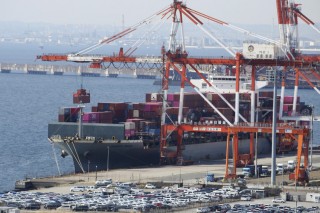Loading
Search
▼ Japan Records Trade Deficit For Third Straight Fiscal Year Despite Recovering Exports
- Category:Other
Japan recorded a trade deficit for the third straight fiscal year as the costs of energy and other imports rose and the yen remained weak.
The deficit was 5.89 trillion yen ($38 billion) for the fiscal year that ended in March, according to Finance Ministry data released Wednesday.
The biggest trade deficits were in the Middle East, mainly Saudi Arabia and the United Arab Emirates, as well as Australia and Indonesia. Japan had a trade surplus with the U.S. and some European countries.
Annual exports to China slipped slightly, declining for the first time in four years, although the latest monthly data show exports to China recovering, growing 12% from the previous year.
Robert Carnell, regional head of research Asia-Pacific at ING Economics, said strong technology-related exports were behind the jump in exports to China, while noting exports were also growing to other regions.
“We think exports will be the main engine for growth in the coming months,” he said in a report.
The recent decline in the value of the Japanese yen affected the trade balance, as it cost more in yen to import and boosted the value of exports when converted to yen. The U.S. dollar is trading at above 150 yen recently, up from 130-yen mark a year ago.
Data for the month of March, also released Wednesday, showed Japan marked a trade surplus of 366.5 billion yen ($2.4 billion), as exports grew 7% from a year ago, while imports declined nearly 5%. Exports to the U.S. in March grew more than 8%.
The fiscal 2023 trade deficit was much smaller than what was racked up in fiscal 2022, when the economy was hit by the war in Ukraine and energy prices soared. It was about the same as what was recorded in fiscal 2021. Japan had a trade surplus in fiscal 2020.
The social restrictions related to the coronavirus pandemic made securing parts, including computer chips, a challenge, denting Japan’s production and exports. But such problems have gradually eased.
By product category, Japan imported food, while exporting autos, auto parts and electrical machinery. Inbound tourism is booming, which counts statistically as an export.
The deficit was 5.89 trillion yen ($38 billion) for the fiscal year that ended in March, according to Finance Ministry data released Wednesday.
The biggest trade deficits were in the Middle East, mainly Saudi Arabia and the United Arab Emirates, as well as Australia and Indonesia. Japan had a trade surplus with the U.S. and some European countries.
Annual exports to China slipped slightly, declining for the first time in four years, although the latest monthly data show exports to China recovering, growing 12% from the previous year.
Robert Carnell, regional head of research Asia-Pacific at ING Economics, said strong technology-related exports were behind the jump in exports to China, while noting exports were also growing to other regions.
“We think exports will be the main engine for growth in the coming months,” he said in a report.
The recent decline in the value of the Japanese yen affected the trade balance, as it cost more in yen to import and boosted the value of exports when converted to yen. The U.S. dollar is trading at above 150 yen recently, up from 130-yen mark a year ago.
Data for the month of March, also released Wednesday, showed Japan marked a trade surplus of 366.5 billion yen ($2.4 billion), as exports grew 7% from a year ago, while imports declined nearly 5%. Exports to the U.S. in March grew more than 8%.
The fiscal 2023 trade deficit was much smaller than what was racked up in fiscal 2022, when the economy was hit by the war in Ukraine and energy prices soared. It was about the same as what was recorded in fiscal 2021. Japan had a trade surplus in fiscal 2020.
The social restrictions related to the coronavirus pandemic made securing parts, including computer chips, a challenge, denting Japan’s production and exports. But such problems have gradually eased.
By product category, Japan imported food, while exporting autos, auto parts and electrical machinery. Inbound tourism is booming, which counts statistically as an export.
- April 18, 2024
- Comment (0)
- Trackback(0)


